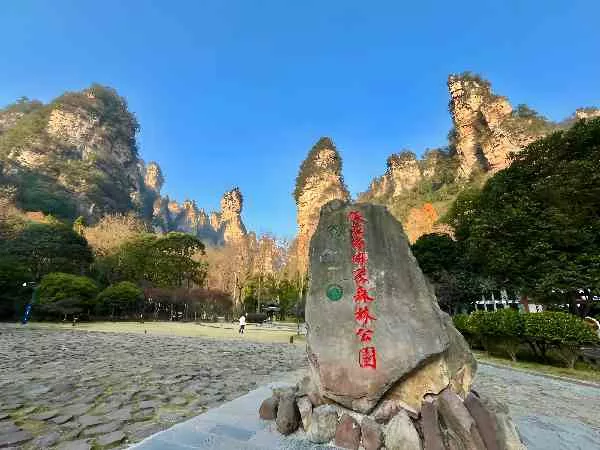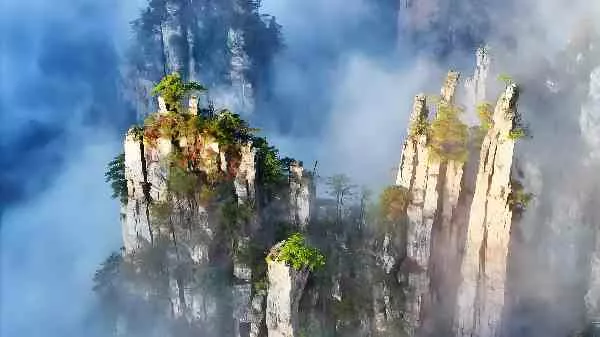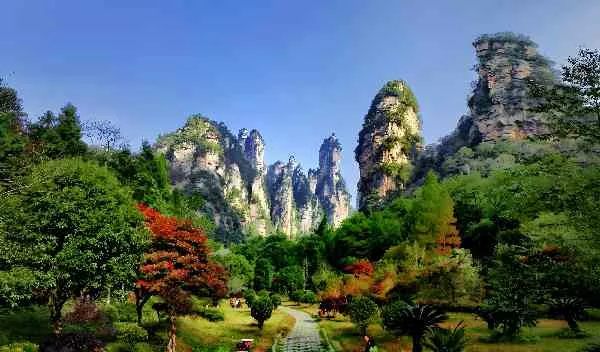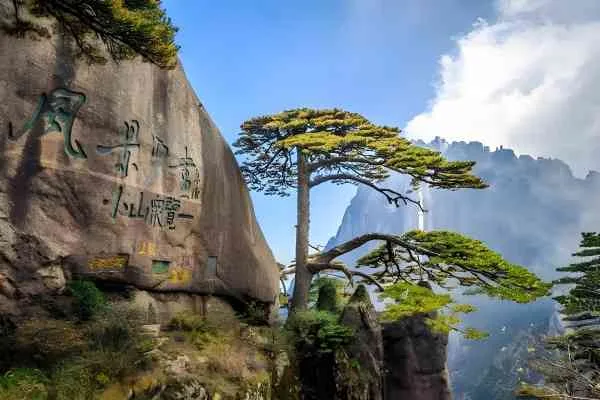Introduction to Zhangjiajie National Forest Park
Nestled in Hunan Province, China, Zhangjiajie National Forest Park is a UNESCO World Heritage Site renowned for its surreal sandstone pillar formations, mist-cloaked valleys, and lush forests. Often referred to as the inspiration behind the “floating mountains” in Avatar, this natural wonder offers American travelers an unforgettable blend of adventure, photography opportunities, and cultural immersion.
Covering an area of over 4,800 hectares, the park is a haven for nature lovers, boasting more than 3,000 towering sandstone pillars, some reaching heights of over 400 meters. These unique rock formations, combined with the park’s rich biodiversity, including rare plant and animal species, create a landscape that is both otherworldly and captivating. Whether you’re an avid hiker, a photography enthusiast, or simply seeking a peaceful retreat in nature, Zhangjiajie National Forest Park has something to offer.

Top Attractions to Explore
The Avatar Hallelujah Mountain (Yubi Peak)
Standing tall at 1,080 meters, the Avatar Hallelujah Mountain, officially known as Yubi Peak, is the crown jewel of Zhangjiajie National Forest Park. This iconic sandstone pillar was the inspiration for the floating mountains in the blockbuster movie Avatar, and its otherworldly presence is a sight to behold.
For a close – up view, hike the well – maintained trails that wind around the peak. Along the way, you’ll be treated to panoramic vistas of the park’s lush greenery and the countless sandstone pillars that dot the landscape. If you’re looking for a quicker way to experience the formations from above, the Bailong Elevator is a thrilling option. This glass – sided lift ascends 326 meters in just over a minute, offering breathtaking views of the cliffs and valleys as you soar upwards.
Tianzi Mountain & The Hundred Dragons Elevator
Tianzi Mountain is a haven for nature lovers and photographers, offering sweeping vistas of over 3,000 sandstone pillars. The best way to reach the mountain’s summit is by taking the Bailong Elevator, the world’s tallest outdoor elevator. As you ascend, you’ll feel a rush of adrenaline as you pass through the cliffs at high speed, and once you reach the top, the panoramic views of the park are simply unforgettable.
At the summit, take your time to explore the many viewpoints and trails. You can also visit the Tianzi Mountain Nature Museum to learn more about the park’s geology, flora, and fauna. Don’t forget to bring your camera, as the light and shadow play on the sandstone pillars throughout the day create ever – changing, picture – perfect scenes.
Golden Whip Stream (Jinbian Xi)
For a more leisurely and peaceful experience, the Golden Whip Stream is the perfect choice. This serene 7.5 – kilometer trail follows the course of a crystal – clear stream, lined with ancient trees and dramatic rock formations. As you stroll along the path, you’ll be surrounded by the sounds of nature: the gentle babbling of the stream, the chirping of birds, and the rustling of leaves in the wind.
Keep your eyes peeled for the local wildlife. Monkeys are often spotted along the stream, swinging from tree to tree and playing with each other. The stream is also home to a variety of fish, and if you’re lucky, you might even catch a glimpse of a Chinese giant salamander, one of the world’s largest amphibians. The unique flora along the stream, including many rare and endemic plant species, adds to the charm of this natural wonder.
Tianmen Mountain Skywalk
If you’re an adrenaline junkie, the Tianmen Mountain Skywalk is an experience you won’t want to miss. This glass – bottomed walkway is suspended high above the valley floor, offering heart – pounding views of the abyss below. As you walk across the skywalk, you’ll feel like you’re walking on air, and the sense of danger and excitement is sure to get your blood pumping.
To reach the skywalk, you can take the world’s longest cable car ride, which offers stunning views of the mountain and the surrounding landscape. Once you’re at the top, in addition to the skywalk, you can explore the many other attractions on Tianmen Mountain, such as the Tianmen Cave, a natural karst cave that is one of the mountain’s most famous landmarks.
Practical Tips for American Travelers
Best Time to Visit
The optimal times to visit Zhangjiajie National Forest Park are during spring (April – June) and autumn (September – November). Spring brings blooming wildflowers and fresh greenery, painting the park in vibrant colors. Autumn, on the other hand, offers clear skies and the foliage turns into a palette of warm hues, creating a breathtaking backdrop for hiking and photography. The weather during these seasons is generally mild, with temperatures ranging from 15 – 25°C (59 – 77°F), making it comfortable for outdoor activities.
It’s advisable to avoid the summer months (June – August) if you can, as the park can get extremely crowded with domestic and international tourists. The heat can also be intense, with temperatures sometimes soaring above 30°C (86°F). Winters (December – February) are cold, and while the snow – covered landscape can be beautiful, some trails may be icy and dangerous, and there may be more frequent fog, which can limit visibility of the stunning views.
Getting There
The most convenient way to reach Zhangjiajie for international travelers is to first fly into a major Chinese city like Shanghai or Beijing and then transfer to a flight to Zhangjiajie Hehua International Airport (DYG). There are direct flights from several major Chinese cities to Zhangjiajie, and the flight duration varies depending on your departure point. For example, a flight from Shanghai to Zhangjiajie takes about 2.5 hours.
Once you arrive at the airport, you can take a taxi to the park entrance, which is a relatively straightforward option but may be a bit pricier. A more budget – friendly alternative is to take a shuttle bus. These shuttle buses operate on fixed routes and schedules, connecting the airport to various locations near the park, including the main entrances. Be sure to check the shuttle bus schedule in advance, especially if you have a tight itinerary.
Inside the park, an efficient eco – friendly bus system is the primary mode of transportation between different attractions. These buses are clean, comfortable, and run frequently, making it easy to get around. However, English – language maps and signage can be limited. To overcome this challenge, it’s a good idea to download a translation app on your smartphone before your trip. Apps like Google Translate can be very helpful for understanding signs, communicating with local staff, and getting directions.
If you prefer a more guided experience, hiring a local guide is an excellent option. A local guide not only knows the best trails, viewpoints, and hidden gems in the park but can also provide in – depth information about the park’s geology, history, and local culture. They can help you navigate the park more efficiently, ensuring you make the most of your time and get the best possible experience.
Accommodation Recommendations
For the utmost convenience, staying in Wulingyuan, which is close to the park entrance, is highly recommended. There is a wide range of accommodation options to suit every budget. Budget travelers can find comfortable hostels in the area, offering shared dormitory rooms or private rooms at affordable prices. These hostels often provide a great opportunity to meet other travelers and exchange travel tips.
If you’re looking for a more luxurious stay, resorts like Pullman Zhangjiajie Wulingyuan offer top – notch amenities. You can enjoy a spa, fine dining, and well – appointed rooms with stunning views of the surrounding mountains. Other high – end options include the Hilton Huanying Zhangjiajie National Forest Park, which provides excellent service and modern facilities. Mid – range hotels in Wulingyuan also offer a good balance between comfort and cost, with many providing shuttle services to the park entrance, making your daily commute to the park hassle – free.

Cultural Experiences in Zhangjiajie
Tujia Minority Villages
A visit to Zhangjiajie isn’t complete without exploring the rich cultural heritage of the local Tujia minority. Head to villages like Xibu Ancient Town, where the traditions of the Tujia people come alive. As you stroll through the cobblestone streets, you’ll be transported back in time, surrounded by well – preserved ancient architecture that reflects the unique style of the Tujia.
One of the highlights of visiting these villages is experiencing the traditional dance performances. The Tujia people are known for their energetic and rhythmic dances, such as the Hand – Waving Dance. This dance, with its complex hand gestures and lively steps, is often performed during festivals and celebrations, and it’s a great way to immerse yourself in the local culture. You can join in the fun and learn some of the basic steps from the friendly locals, creating memories that will last a lifetime.
Another aspect of Tujia culture to discover is their craftsmanship. Tujia artisans are highly skilled in creating intricate handicrafts, including beautiful brocade and hand – carved wooden items. Watch as the artisans work their magic, using traditional techniques passed down through generations. You can even purchase some of these unique handicrafts as souvenirs, not only to remember your trip but also to support the local economy and preserve these traditional arts.
Local Cuisine
No cultural experience is complete without savoring the local cuisine. Zhangjiajie offers a tantalizing array of Tujia dishes that are sure to delight your taste buds. One must – try dish is 腊肉 (là ròu), or smoked pork. This flavorful meat is cured and smoked over a slow fire, giving it a distinct smoky flavor that pairs well with a variety of side dishes. The curing process not only adds flavor but also preserves the meat, a technique that has been used by the Tujia people for centuries.
For a heartier meal, sample 三下锅 (sān xià guō), a three – ingredient hotpot. This dish typically consists of a combination of meats (such as pork, beef, or offal) and vegetables, all cooked together in a spicy broth. The spices used in the broth are a unique blend that gives the dish its signature flavor, with a perfect balance of heat, saltiness, and umami. It’s a communal dish, often shared among friends and family, and is best enjoyed with a bowl of steamed rice.
If you’re looking for a lighter option, 米豆腐 (mǐ dòu fu), or rice tofu, is a great choice. Made from rice, this soft and delicate tofu – like dish is often served with a spicy sauce and various toppings, such as pickled vegetables and minced meat. The cool and smooth texture of the rice tofu provides a refreshing contrast to the spicy sauce, creating a harmonious blend of flavors. You can find these delicious dishes at local eateries, many of which offer a rustic and authentic dining experience, allowing you to enjoy the food in a traditional setting.
Safety & Sustainability
Hiking Safety
Safety should be a top priority when exploring Zhangjiajie National Forest Park, especially when hiking its many trails. The park’s terrain can be challenging, with steep inclines, uneven paths, and sometimes slippery surfaces, especially after rain. Wearing sturdy hiking boots is essential. These boots provide ankle support, which is crucial for preventing sprains on uneven ground, and have good traction to keep you stable on steep slopes.
Carrying an adequate supply of water is non – negotiable. Hiking can be strenuous, and staying hydrated is key to avoiding fatigue and heat – related illnesses. It’s recommended to bring at least 1 – 2 liters of water per person, depending on the length and difficulty of the hike and the weather conditions.
Following the park’s guidelines is also important for your safety and the preservation of the park’s natural environment. The park authorities have set up marked trails to ensure that visitors do not wander into dangerous or environmentally sensitive areas. Straying off the designated paths can not only put you at risk of getting lost or injured but also damage the fragile ecosystems that the park is home to.
Reduce Environmental Impact
Preserving the natural beauty of Zhangjiajie National Forest Park is a responsibility that every visitor should take seriously. One of the simplest ways to reduce your environmental impact is to properly dispose of waste. The park provides trash bins at various locations, and it’s important to use them. Littering not only spoils the aesthetic appeal of the park but can also harm wildlife. Animals may mistake trash for food, leading to injury or death.
Avoiding single – use plastics is another significant step towards environmental conservation. Single – use plastics, such as water bottles, straws, and plastic bags, are major pollutants. They take hundreds of years to decompose and often end up in landfills, oceans, or natural habitats like Zhangjiajie. Bringing a reusable water bottle, cloth shopping bags, and a reusable food container can significantly reduce your plastic waste. Many areas in the park also offer water refill stations, making it convenient to keep your reusable bottle filled. By making these small but impactful choices, you can help ensure that Zhangjiajie National Forest Park remains a pristine natural wonder for generations to come.

Sample Itinerary for a 3-Day Trip
Day 1: Explore Yuanjiajie and the Avatar Hallelujah Mountain
Morning:
Start your day early by arriving at the Zhangjiajie National Forest Park entrance. Take the eco – friendly bus to the Bai Long Elevator. Ride the elevator up to Yuanjiajie, which offers a thrilling start to your adventure with its rapid ascent and panoramic views of the sandstone pillars.
Once at Yuanjiajie, head straight to the Avatar Hallelujah Mountain. Marvel at the iconic sandstone pillar that inspired the floating mountains in Avatar. Walk along the well – maintained boardwalks around the peak, taking in the stunning views of the surrounding forest – covered pillars and the deep valleys below. Don’t forget to take plenty of photos, especially from the viewpoints that offer the best angles of the mountain.
Afternoon:
Explore the rest of Yuanjiajie. Wander along the paths that wind through the unique rock formations, and discover hidden viewpoints. You can also visit the Yuanjiajie Natural Bridge, a natural wonder that spans across the cliffs.
In the late afternoon, take the bus to your accommodation in Wulingyuan. Check – in and relax for a while, or take a stroll around the town to get a feel for the local atmosphere.
Day 2: Hike Golden Whip Stream and take the Bailong Elevator to Tianzi Mountain
Morning:
Begin your day at the Golden Whip Stream. Enter the park and follow the signs to the stream. The 7.5 – kilometer trail is a gentle and scenic hike, perfect for a morning walk. As you walk along the clear stream, you’ll be surrounded by ancient trees, unique rock formations, and the sounds of nature. Keep an eye out for the local monkeys that often play along the trail.
Stop at the Golden Whip Rock, a towering sandstone pillar that is one of the highlights of the stream. Take photos and learn about the legend behind the rock from the information boards along the way.
Afternoon:
After finishing the hike, take the bus to the Bailong Elevator. Ride the elevator up to Tianzi Mountain. At the top, head to the Tianzi Mountain Scenic Area. Explore the many viewpoints, such as the Shentang Bay, where you can look down into a deep, mysterious valley.
Visit the Tianzi Mountain Nature Museum to learn more about the park’s geology, flora, and fauna. The museum has a collection of specimens and exhibits that provide a fascinating insight into the natural history of the area.
Day 3: Visit Tianmen Mountain Skywalk and explore Tujia cultural sites
Morning:
Take a taxi or shuttle bus to Tianmen Mountain. Take the world – longest cable car ride up to the mountain. The cable car ride offers stunning views of the city and the surrounding mountains.
Once at the top, head to the Tianmen Mountain Skywalk. Walk across the glass – bottomed walkway for a thrilling experience, looking down at the deep valley below. If you’re feeling brave, try to walk to the center of the skywalk for an even more heart – pounding view.
Afternoon:
After the skywalk, explore the rest of Tianmen Mountain. Visit the Tianmen Cave, a large natural karst cave that is one of the mountain’s most famous landmarks. You can take a tram or walk up the steps to reach the cave.
In the late afternoon, head to a Tujia cultural site, such as Xibu Ancient Town. Wander through the cobblestone streets, admire the traditional Tujia architecture, and watch traditional dance performances. Try some local Tujia cuisine at one of the restaurants in the town before ending your day.
Conclusion
Zhangjiajie National Forest Park offers American travelers a one – of – a – kind adventure in the heart of China’s Hunan Province. From the otherworldly sandstone pillars of the Avatar Hallelujah Mountain to the serene beauty of the Golden Whip Stream, every corner of the park is filled with natural wonders waiting to be discovered.
The cultural experiences, such as exploring Tujia minority villages and savoring local cuisine, add a rich layer to your visit, allowing you to connect with the region on a deeper level. By following the practical tips on travel, safety, and sustainability, you can ensure a smooth and responsible trip.
Whether you’re a nature enthusiast, a culture vulture, or simply seeking a break from the ordinary, Zhangjiajie National Forest Park promises an unforgettable journey. So, start planning your trip, and get ready to be amazed by the beauty of this UNESCO – recognized paradise.
